Felinfoel is a small village that borders the town of Llanelli, and is famous as being the home of the Felinfoel Brewery. The War Memorial is located within Holy Trinity Churchyard, in the form of a Celtic cross, and commemorates the men of the village who lost their lives during the Boer War, the Great War, and World War Two. These men are commemorated below.
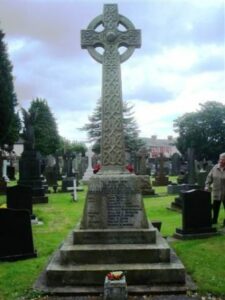
Boer War, 1899-1902
Joseph Davies, Corporal, 2109, 1st Battalion, Welsh Regiment. Joseph was born at Llanelli in 1869, the son of William and Jane Davies. He married Dora Ann Lloyd of Felinfoel on 15 October 1899, prior to sailing for South Africa with the 1st Battalion, Welsh Regiment. Joseph was killed in action during the Welsh Regiment’s successful assault on the strongly defended Boer position at Driefontein on 10 March 1900. He is buried at Driefontein, Bosrand. Joseph is commemorated on the new war memorial at Five Roads.
Richard Howell, Corporal, 248, Diamond Fields Horse. Richard was from Felinfoel, and was the son of David and Margaret Howell, of the Hope and Anchor, Llanelli. He was among 19 men killed in action at Carters Ridge, Kimberley on 28 November 1899. He was 24 years old, and is buried at Kimberley, and commemorated on the Honoured Dead Memorial. Richard is also commemorated on the Carmarthen Boer War Memorial and the Llanelli Boer War Memorial.
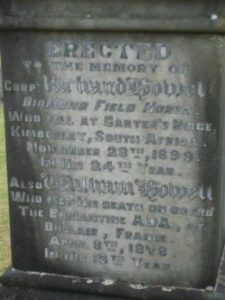
The Great War, 1914-1918
John Arthur Dade, Private, 15459, Royal Welsh Fusiliers. John was born at Nottingham in 1893, the son of Samuel and Annie Dade. The family had lived at Llandeilo for several years before moving to Bank Cottage, Felinfoel. John enlisted into the 10th Battalion, Royal Welsh Fusiliers, which was attached to 76 Brigade, 3rd Division. One of the first Divisions to move to France, the 3rd Division remained on the Western Front throughout the war, and fought during the opening Battle of Mons, and in the epic retreat, from the Rearguard Action of Solesmes, through the Battle of Le Cateau, and down to the Marne, where the German Offensive was stopped. They followed the German withdrawal to the Hindenburg Line, where they met them in battle, and stopped the advance on Paris. The Division then moved north to Flanders, and took part in the Battle of La Bassée, and at the Battle of Messines, which were a prelude to the First Battle of Ypres. They took part in the famous Christmas Truce on 25 December 1914 and remained at Ypres throughout the winter. In 1915 the Division saw action at Bellewaarde and Hooge, and took part in the Second attack on Bellewaarde, and in 1916 fought at the Actions of the Bluff, and at the St Eloi Craters. They were then moved south to the Somme, where they were to take part in the great Battle of the Somme, and fought there at the Battle of Albert, and at the Battle of Bazentin, where they captured Longueval. John was wounded on the Somme, and brought back to the Casualty Clearing Station at Corbie, where he died of his wounds on 21 August 1916. He was 23 years old, and is buried at La Neuville British Cemetery, Corbie, France. John is not listed on the Felinfoel Memorial.
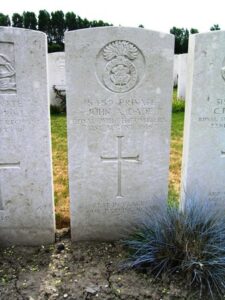
Trevor Daniel, Private, 202975, Welsh Regiment. Trevor was the son of Griffith and Mary Ann Daniel, of Ivy Cottage, Felinfoel, and he enlisted at Llanelli into the 13th Battalion, Welsh Regiment, which was attached to 114 Brigade, 38th (Welsh) Division. The Division had landed in France during December 1915 and had spent their first winter in the trenches near Armentieres. In June they marched south to the Somme, where they famously captured Mametz Wood during July 1916. The Division suffered terrible casualties at Mametz, and were taken out of the line, and moved to Ypres to rebuild. Here they fought at Pilckem and Langemarck, then moved to Armentieres, where they remained from September 1917 until March 1918, when the German Spring Offensive was launched. The British had been over-run on the Somme, and so in April the Division was moved South, taking up positions North of Albert, from where they weathered the storm of the coming months, until the war turned during the Battle of Amiens, on 8 August 1918. The Germans had now lost the upper hand, and the British regained the lost ground on the Somme after an attack which began on 21 August 1918, with the 38th Welsh in the midst of the attack during the Battle of Albert, and then moving east, where they fought at the Battle of Bapaume. Trevor was killed in action here on 3 September 1918. He was 21 years old, and is buried at Fins New British Cemetery, Sorel-Le-Grand, France.
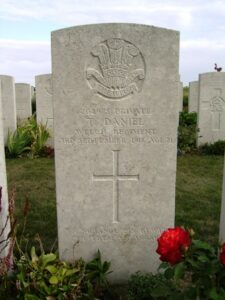
Henry Davies, Private, 13151, Royal Welsh Fusiliers. Henry was the son of William and Mary Davies, of 14, Adulam Row, Felinfoel. He enlisted at Llanelli within weeks of the outbreak of war, into the 9th Battalion, Royal Welsh Fusiliers. The battalion had formed at Wrexham in September 1914, before moving to Tidworth to join 58 Brigade, 19th (Western) Division. On 19 July 1915 Henry landed in France with the battalion, and the entire 19th Division then moved to the Nursery Sector at Calonne for trench initiation alongside the Dehra Dun Brigade. The infantry battalions of the division then began carrying out the usual routines of rotating in the trenches: four days in the front line; four in support; and four in reserve, interspersed with training regimes and carrying out working parties and trench raids. Just south, the British launched a great offensive around the town of Loos on 25 September 1915, and the 19th Division was ordered to attack from its positions at the same time, to attempt to draw enemy attention away from the main battle area. The attacking battalions of the 19th Division were in place by 04.00, and then at 05.50 the men climbed out of their trenches to launch their assault, behind a gas and smoke screen. The assault was a disaster, and heavy casualties were suffered by the 19th Division for no gain. Henry was killed in action here that day. The 37-year-old has no known grave and is commemorated on the Loos Memorial, France.
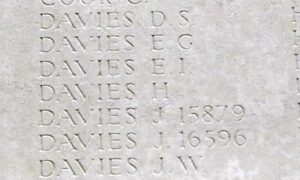
James Davies, MM, Lance Corporal, Deal/3477/S, Royal Marines. James was born at Port Talbot on 21 July 1886. Prior to the war he resided with his wife Elizabeth Davies, at Glyncelyn, Felinfoel. He enlisted on 9 February 1915 into the RM Medical Unit, and was posted to the 3rd (RN) Field Ambulance, Royal Naval Division. The division moved to Egypt preparatory to the Gallipoli campaign, and landed on 25 April 1915. After the evacuation of Gallipoli, the Division was transferred from the Admiralty to the War Office, and was redesignated the 63rd (Royal Naval) Division on 19 July 1916 after having moved to France in May 1916. The division moved to positions on the Somme, where it took part in the Battle of the Ancre, and the resulting Operations on the Ancre. In April 1917 the Division were at Arras, and fought at the Second Battle of the Scarpe, where they captured Gavrelle. They then fought at the Battle of Arleux, before moving north to Ypres, where they took part in the Second Battle of Passchendaele. Their next major action was at Cambrai, during the Action of Welch Ridge, and they were still in the area when the Germans launched their Spring Offensive, and fought at the Battle of St Quentin, and then the First Battle of Bapaume. In August, the Division took part in the Battle of Albert, which marked the beginning of the great offensive which was to end the war. They then fought at the Battle of Drocourt-Queant, the Battle of the Canal du Nord and the Battle of Cambrai, before forcing the Passage of the Grand Honelle. James sadly died of the influenza epidemic that swept through Europe at the end of the war, on 20 November 1918. He was 32 years old, and is buried at Etaples Military Cemetery, France. He had been awarded the Military Medal during the Somme Offensive for; ‘He displayed great courage and energy in removing patients from a position which was being heavily shelled to one of greater safety on 14 November 1916 near the River Ancre’. James is not named on the Felinfoel Memorial.
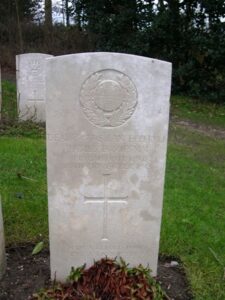
Daniel Morgan Evans, Private, 14878, South Wales Borderers. Daniel was the son of William and Elizabeth Evans, of 2, Salem Road, Felinfoel. He had served from the age of 16, in the 1st Welsh, then the Royal Marines and the Royal Navy. At the outbreak of the Great War he re-enlisted at Aberystwyth into the 1st Battalion, South Wales Borderers, which was attached to 3 Brigade, 1st Division. The Division had been one of the first to arrive in France, fighting at the Battle of Mons, and taking part in the retreat to the Marne, where the Germans were stopped. They then fought at the Aisne, and at Chivy, before being moved North to Ypres. Here they fought at the First Battle of Ypres, where they again stopped the German Offensive, before wintering in Flanders. Daniel was killed in action here, during the Defence of Givenchy, on 21 December, 1914. He was 31 years old, and is remembered on the Le Touret Memorial, Richebourg L’Avoue, France. His widow Catherine had remarried in 1917, becoming Catherine Siddell, of 33, Greengate Street, Carnarvon. She was widowed soon after, and remarried in 1925. Daniel is not named on the Felinfoel Memorial.
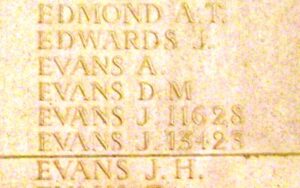
Herbert Ronald Evans, Acting Sergeant, C/1238, Kings Royal Rifle Corps. Hubert was the son of Thomas and Elizabeth Evans, of 8, Nevil’s Terrace, Dafen. He was a fuser in the local tinplate works prior to the war. Herbert enlisted at Llanelli into the Kings Royal Rifle Corps. Herbert was later posted along with a draft of other men of the King’s Royal Rifle Corps to East Africa, to fight against the German occupational forces there, and transferred into the 1/2nd Battalion, Kings African Rifles, with the service number 26366. Sadly, he became ill and died of sickness in Mozambique on 24 April 1918. The 30-year-old is buried in Pemba Cemetery, Mozambique.
Joseph Evans, Private, L/15904, Middlesex Regiment. Joseph resided at Penygaer, Dafen, and enlisted there into the Royal Hussars. He later transferred into the 1st Battalion, Middlesex Regiment, which had landed at Havre as Lines of Communication Troops on 11 August 1914. On 22 August, 1914 they were attached to 19th Brigade, forming at Valenciennes, and on 12 October moved with 19th Brigade, to the 6th Division. On 31 May 1915 they again moved, to the 27th Division, and by 19 August were with the 2nd Division at Loos. Here they took part in the opening assault of the Battle of Loos, near Cambrin, on 25 September 1915. Joseph was killed in action this day, and is buried at Cambrin Churchyard Extension, France.
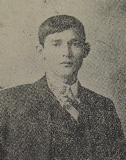
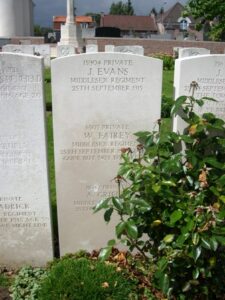
Alban Henry Gaunt, Private, CMT/377, Royal Army Service Corps. Henry was the son of George and Harriet Gaunt, of Burton Joyce, Nottinghamshire. He had resided at Haverfordwest prior to 1907, and married Jessie Evelina John in 1907. The couple then spent periods living at Skewen, Coedfranc and at Swansea and Felinfoel prior to the outbreak of war, with Henry working as a Driver for Buckleys Breweries. When war erupted, Henry enlisted at Llanelli as a Driver with the Base M.T. Depot, Army Service Corps. Jessie by now had moved with their children to The Bull Inn, Prendergast, Haverfordwest, to be back with her family. Henry moved to France with the BEF at the outbreak of war, and was wounded by shell fragments at the Battle of Mons. He died of wounds on 24 August 1914, aged 28. Henry has no known grave, and is commemorated on the La Ferte-Sous-Joarre Memorial, France. Jessie remarried twice afterwards, and died in Staffordshire in 1953.
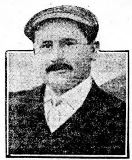
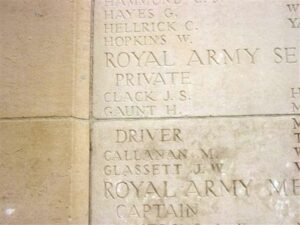
Edgar Griffiths, Private, 75896, Welsh Regiment. Edgar was the son of James and Elizabeth Griffiths, of Penygaer Isaf, Felinfoel. He enlisted at Llanelli into the 4th Battalion, Welsh Regiment on 11 December 1915. Edgar survived the war, but took ill before being discharged as medically unfit on 28 August 1918. He returned to Llanelli where he died of meningitis on 10 January 1920. He is not commemorated by the CWGC.
Ivor Samuel Griffiths, Private, 20499, Welsh Regiment. Ivor was the son of William and Mary Ann Griffiths, of 10, Glanyrafon Row, Felinfoel, and had enlisted at Llanelli into the 15th Battalion, Welsh Regiment, known as the Carmarthen Pals battalion, which was trained at Rhyl, before landing in France in December 1915 attached to 114 Brigade, 38th (Welsh) Division. The Division had familiarised into trench warfare around Fleurbaix, and Givenchy. In June 1916 they marched south to the Somme, where they were tasked with the capture of Mametz Wood. The attack on the wood began on 7 July 1916, but met with fierce resistance, so the Welshmen were withdrawn, and after a change in Commanding Officer, a fresh attack was launched on 10 July 1916. Ivor was killed in action during heavy hand to hand fighting within Mametz Wood, on 11 July 1916. He was just 19 years old, and is buried at Flatiron Copse Cemetery, Mametz, France.
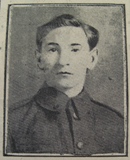
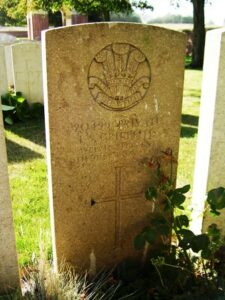
Robert Griffiths, Private, 73685, Welsh Regiment. Robert was the son of John and Jane Griffiths, of 17, Long Road, Felinfoel. He was a collier prior to enlisting on 4 February 1916 into the Welsh Regiment. Robert landed in France on 3 October 1918, joining the 15th Battalion, Welsh Regiment, which was the Carmarthen pals battalion, attached to 114 Brigade, 38th (Welsh) Division. The division had been in France since December 1915, and had fought at Mametz Wood and Pilckem Ridge. The division began its part in the great offensive by crossing the flooded River Ancre on 21 August 1918, and over the coming days pushed the Germans back across the old Somme battlefields of 1916, towards the Canal du Nord. A short rest period ensued, during which time the Canal du Nord was breached, so opening a passage through the Hindenburg Line. The Division then fought at the Battle of Beaurevoir, and moved up towards Cambrai, capturing Villers-Outreaux, before advancing to the river Selle, where the 15th Welsh again afforded a river crossing, under heavy fire. Robert was killed here on 20 October 1918, aged 32, and is buried at Montay-Neuvilly Road Cemetery, France.
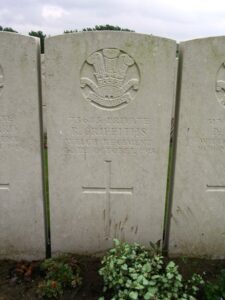
John Edwin Howell, Second Lieutenant, Welsh Regiment. John was the son of John and Anne Howell, of Pantymeillion Farm, Llanelli, and had originally served with the Pembroke Yeomanry since enlisting in 1909. At the outbreak of war he had been commissioned into the Welsh Regiment. He was posted to the 16th Battalion, Welsh Regiment, which was attached to 115 Brigade, 38th (Welsh) Division. The Division had landed in France during December 1915 and had spent their first winter in the trenches near Armentieres. In June they marched south to the Somme, where they were tasked with the capture of Mametz Wood. The attack on the wood began by an attack by the 16th Welsh on 7 July 1916, but met with fierce resistance, and the attack was temporarily delayed. John was killed in action during this initial assault on Mametz Wood, on 7 July 1916. He was 23 years old, and is remembered on the Thiepval Memorial, France.

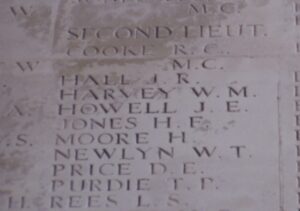
David John Hughes, Lieutenant, Welsh Regiment. David was born in Pwll, Llanelli on 14 August 1892, the son of David and Betsy Hughes. He had served with the South African Heavy Artillery before being commissioned into the 3rd Welsh on 9 December 1915. David then returned home and was married, living briefly with his wife Muriel Hughes, at 26, College Hill, Llanelli. He was promoted Lieutenant on 1 July 1917 and was posted to the 13th Welsh on 7 August 1918. On arrival in France he was re-posted to the 15th Welsh, the Carmarthen Pals battalion, joining them from the Reinforcement Depot at Rouen on 1 September 1918. David was put in Command of D Company upon joining the Battalion and was wounded by bullets in both thighs while leading them at Dessart Wood on 18 December 1918. He returned home for treatment, but died in Llanelli on 8 March 1921, aged 28, and is buried at Box Cemetery, Llanelli.
Frederick George Jayne, Sergeant, 4438, Welsh Regiment. Frederick was the son of Frederick William and Sarah Ann Jayne, of Crumlin, Coleshill Terrace, Llanelli. He married Sarah Giles in 1912, and the couple lived at 7, Birdin Terrace, Felinfoel. Frederick enlisted at Llanelli into the 1/4th Battalion, Welsh Regiment, which had formed locally during August 1914 and were then attached to 159 Brigade, 53rd (Welsh) Division. The Division moved to the Mediterranean, sailing from Devonport in July 1915, and landed at Cape Helles, Gallipoli via Mudros on 9 August 1915. Here they immediately faced the chaotic leadership that was to lead to the ultimate failure of the campaign, and spent the next few days in isolated pockets, fighting against a Turkish counter-attack. Frederick was wounded here during the Battle of Sari Bair, and died of wounds aboard a Hospital Ship on 11 August 1915, aged 33. He was buried at sea, and so he is remembered on the Helles Memorial, Gallipoli. Sarah died in 1934. His brother, Walter Havard Joseph Jayne also fell.
Cledwyn Lloyd Jones, Second Lieutenant, Notts & Derby (Sherwood Foresters). Cledwyn was the son of Richard and Annie Jones, of Hilltop, Tyrfran, Llanelly, and was commissioned from the Royal Fusiliers into the Sherwood Foresters on 30 October 1917. Cledwyn was posted to the 2/7th Battalion, which was attached to 178 Brigade, 59th (2nd North Midland) Division. In April 1916 the Division moved to Ireland, and was the first TF Division to serve there, involved in actions against the Republican Uprising of Easter 1916. During January 1917 they returned to England, and the following month landed in France. They followed the German Retreat to the Hindenburg Line, and then moved north, taking part in the Battle of the Menin Road (part of the Third Battle of Ypres), and the Battle of Polygon Wood. Later that year they moved south, and took part in the Battle of Cambrai. They remained in this sector over the final winter of the war, and on 21 March 1918 were one of the Divisions hit here by the German Spring Offensive, at the Battle of St Quentin. Cledwyn was killed in action here on 21 March 1918, aged 21. He has no known grave, and so is remembered on the Arras Memorial, France.
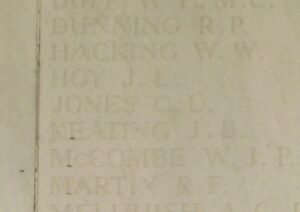
Gwilym Cyrus Jones, Private, 316107, Cheshire Regiment. Gwilym was the son of William Isaac and Muriel Jones, of 19, James Street, Llanelli. He enlisted there into the army, and was posted to the 9th Battalion, Cheshire Regiment, which was attached to 56 Brigade, 19th (Western) Division. The Division had moved to France during July 1915, and moved to positions near Loos. The Division fought during the opening attack of the Battle of Loos, and then moved to the Somme, where they took part in the second wave of the attack on Ovillers-La Boiselle on 1 July 1916, capturing the village at heavy cost, and fought through the Somme Battles of Pozieres and the Ancre in 1916. They then moved North to Ypres, taking part in the Battle of Messines, and fought on the Menin Road and at Polygon Wood, before moving up to Broodseinde, Poelcappelle and Passchendaele Village itself. In 1918 they were caught up in the German Spring Offensive near St. Quentin, where they suffered terrible casualties, and fought at the Battle of Bapaume. Gwilym was killed in action here on 27 March 1918, aged 19. He has no known grave, and so is remembered on the Arras Memorial, France.
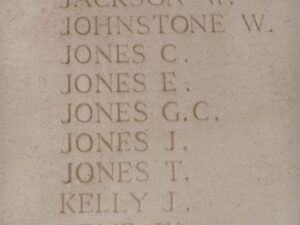
William John Morgan, Second Officer, Mercantile Marine. William was born on 16 October 1894, the son of John Morgan and Elizabeth Morgan (nee Lewis), of Panteg, Felinfoel. He began an apprenticeship as a joiner upon leaving school, but then left Felinfoel and enlisted into the Mercantile Marine in March 1912. He worked his way up the ranks of the Merchant fleet over the coming years and in 1916 gained his certificate to become a Second Mate of a foreign going ship. William served for most of the war with the Mercantile Marine on the Atlantic convoys, but had become ill towards the end of the war and after being diagnosed as suffering from tuberculosis was invalided to Tregaron Sanatorium. He died there of tuberculosis on 17 November 1918. The 24-year-old was buried in Adulam Chapelyard, Felinfoel. William is not commemorated as a casualty of war by the CWGC.
Hubert Thomas Morris, Able Seaman, Wales Z/185, Royal Naval Volunteer Reserve. Hubert was born on 22 April 1897, the son of Joseph and Mary Morris, of 3, Greyhound Row, Felinfoel. He was a tinworker prior to enlisting on 25 January 1915 into the Royal Naval Division. He was posted to join Nelson Battalion, Royal Naval Division at Gallipoli on 20 August 1915, and two months later was invalided to Britain suffering from dysentery. Hubert was posted to France on 25 July 1916, joining Drake Battalion, which was in the Somme sector, attached to the newly formed 63rd (Royal Naval) Division. The division took part in the Battle of the Ancre, and the resulting Operations on the Ancre. In April 1917 the Division were at Arras, and fought at the Second Battle of the Scarpe, where they captured Gavrelle. Hubert was killed in action at Arras on 23 April 1917, aged 20, and is remembered on the Arras Memorial, France.
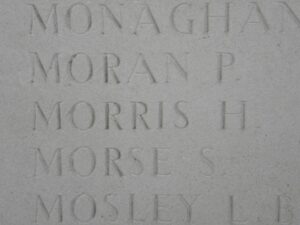
Cyrus Price, Private, 31167, Royal Welsh Fusiliers. Cyrus was born at Felinfoel in 1894, the son of Thomas and Margaret Price. The family later resided at Nyth y Drew, Dafen. Cyrus was a tinplater prior to the war and enlisted at Swansea on 1 September 1914 into the Royal Garrison Artillery. On 5 June 1915 he was transferred to the Royal Welsh Fusiliers, and landed in France on 29 September 1915, where he was attached to the 2nd Battalion, Royal Welsh Fusiliers, who by this time were attached to 19 Brigade, 33rd Division. Cyrus was wounded at Cuinchy on 25 April 1916, and after a spell in hospital rejoined the battalion in time for the infamous explosion of the Red Dragon mine on 22 June 1916. The battalion lost a large number of men killed during the explosion, and resulting German attack, and the following month moved to the Somme. Cyrus was killed in action during the attack on High Wood, on 20 July 1916, aged 21. He has no known grave, and so is remembered on the Thiepval Memorial, France. Cyrus is not commemorated at Felinfoel, but at Dafen.
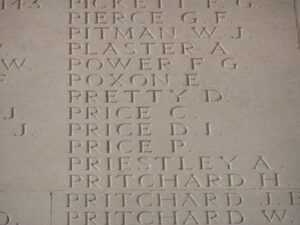
Thomas Rees, Private, 200691, Welsh Regiment. Thomas was the son of John and Hannah Rees, of Llanelli. He married Margaret Davies in 1909, and the couple lived at 6, St. David’s Street, Llanelli. Thomas enlisted at Llanelli into the 1/4th Battalion, Welsh Regiment, which was the local Territorial Battalion, attached to 159 Brigade, 53rd (Welsh) Division. The Division landed at Cape Helles, Gallipoli, on 9 August 1915, and was immediately thrown into action, spending the next few days in isolated pockets, fighting against a Turkish counter-attack during the Battle of Sari Bair, and then at the Attack on Scimitar Hill. The Division remained here throughout the coming months, and suffered severe losses in manpower strength during the great November 1915 blizzard on Gallipoli, when its total strength was reduced to less than that of a full-strength Brigade. On 11 December 1915 the Division was evacuated to Mudros, and by 23 December 1915 were moved to Egypt. They remained on the Suez Canal Defences for the next twelve months, where it took part in operations against the Sultan of Darfur, and in March 1917 took part in the advance into Palestine. Thomas was with the 4/5th Welsh when he was taken ill. He died of disease on 21 November 1918, aged 32, and is buried at Alexandria (Hadra) War Memorial Cemetery, Egypt. His widow, Margaret, married Patrick Mitten of 4, Ynys-Y-Clyn, Felinfoel, after the war, and died in 1952.
William Henry Rees, Private, 14177, Royal Welsh Fusiliers. William was the son of David and Elizabeth Rees, of Tyn Hilian, Felinfoel. He enlisted into the Royal Welsh Fusiliers and landed in France on 5 September 1915 with the 11th Battalion, RWF, which was attached to 67 Brigade, 22nd Division. He appears to have served with the battalion for most of the war, but was posted as a deserter after the Armistice. He was found dead on 2 October 1919, aged 28. William is not commemorated by the CWGC.
Daniel John Reynolds, Private, 260488, Gloucestershire Regiment. Daniel was the son of Daniel Reynolds, of 2, Panteg Row, Felinfoel. Prior to the war he resided with his sister, Mrs. Mary H. Edwards, of 67, Marble Hall Road, Llanelli. He enlisted at Newport into the Monmouth Regiment, and later transferred into the 12th Battalion, Gloucester Regiment. They formed part of 95 Brigade, 5th Division, which had been in France since 15 August 1914, and had fought in the retreat from Mons to the MArne, before moving to Ypres. Here they had fought at First and Second Ypres, then in 1916 fought at the Somme. During 1917 the Division fought during the Battles of Arras. On 7 September 1917, they were pulled out of the line again, and moved north to join the great offensive in Flanders- Third Ypres, or Passchendaele as it is better known. On 26 September they fought at the Battle of Polygon Wood, then at Broodseinde, which is where Daniel was killed in action on 4 October 1917, aged 35. He has no known grave, and so is remembered on the Tyne Cot Memorial, Belgium.
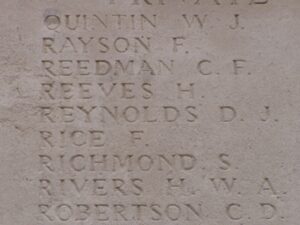
John Henry Richards, Private, 11833, Welsh Regiment. John was the son of Daniel and Margaret Richards, of 8, Western Row, Felinfoel. He enlisted at Tumble into the 8th Battalion, Welsh Regiment, which was part of 40 Brigade, 13th (Western) Division. On the 13th June, 1915 the first transports carrying the Division left port, and moved to Alexandria. By the 4th July, all units had moved to Mudros, and landed at Cape Helles over the next few days, relieving the 29th Division. They left and returned to Mudros at the end of the month, and the entire Division landed at ANZAC Cove between 3 and 5 August 1915, taking part in the Battle of Sari Bair. This is where John was killed in action, on 8 August 1915, aged 27. He has no known grave, and so is remembered on the Helles Memorial, Gallipoli.
Iorwerth Cynon Roberts, Second Lieutenant, Machine Gun Corps. Iorwerth was the son of Edward and Margaret Roberts, of Felinfoel. He married Mary Elizabeth Jones in 1908, and the couple resided at 1, Birden Terrace, Felinfoel, where they raised two daughters. Iorwerth was commissioned into the Machine Gun Corps, and was posted to their 25th Battalion, attached to 25 Division. The Division landed in France on 26 September 1915, and were posted to the Vimy area, where they defended Vimy Ridge against a German attack in May 1916, then moved to the Warloy area and attacked on the 3rd July near Thiepval. They fought throughout the Battle of the Somme, then moved to Plougsteert, where they held the line, until taking part in the Battle of Messines in June, 1917. They fought at Pilckem, before moving south again, taking up positions around Bullecourt in reserve, and were used to reinforce the badly depleted British units that were hit in the area by the German Spring Offensive. They moved north to Flanders to rest, but they were again hit by a renewed German Offensive, and fought at the Battle of Estaires, where Iorwerth was killed in action on 10 April 1918, aged 33. He has no known grave, and so is remembered on the Ploegsteert Memorial, Belgium.
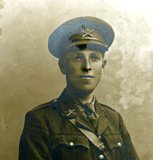
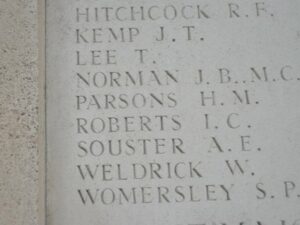
William Hugh Roberts, Private, 54020, Welsh Regiment. William was born in Felinfoel, the son of William and Mary Roberts. The family lived near Salem Chapel, Felinfoel for many years, but by 1911 had moved to 4, Pontardulais Road, Gorseinon, where William’s father had found work in a steelworks. William himself worked as a coal hewer, before enlisting at Cardiff into the 4th Battalion, Welsh Regiment. He was posted to France at some time after 1916, joining the 9th Battalion, Welsh Regiment, which was attached to 58 Brigade, 19th (Western) Division. William was wounded during the division’s gallant defence of Messines during the Battle of the Lys in April 1918, and died of his wounds on 15 April 1918, aged 33. He is buried in Mendinghem Military Cemetery, Belgium. William is not commemorated locally.
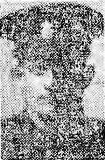
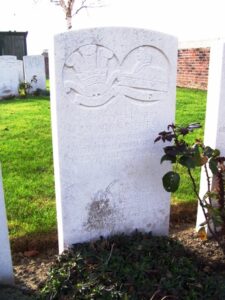
Walter Slipp, Private, 206247, Worcestershire Regiment. Walter was the son of Henry Joseph Slipp and Rose Slipp, of 61, Lampard’s Buildings, Bath. He enlisted at Llanelli into the Cheshire Regiment, but later transferred into the 1st Battalion, Worcestershire Regiment, which was attached to 24 Brigade, 8th Division. The 8th Division was formed during October 1914, by the bringing together of regular army units from various points around the British Empire. The Division moved to the Western Front in November 1914, a badly-needed reinforcement to the BEF which had been all but wiped out at Ypres. They saw their first major action at the Battle of Neuve Chapelle, and then at the Battle of Aubers. They then saw further fighting at the Action of Bois Grenier, before moving to the Somme in 1916, where they fought at the Battle of Albert. In March 1917 they followed the German Retreat to the Hindenburg Line, and later that year moved to Ypres, fighting at the Battle of Pilckem, and the Battle of Langemarck. In March 1918 the Division were on the southern end of the Somme, and here met the German Offensive head on, at the Battle of St Quentin. Walter was killed in action here on 24 August 1918, aged just 21. He has no known grave, and so is remembered on the Pozieres Memorial, France.
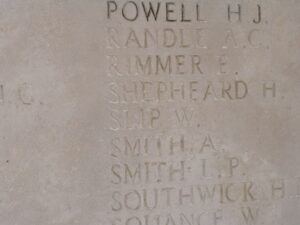
Arthur James Stratton, Private, 25707, Royal Welsh Fusiliers. Arthur was the son of John and Rosina Stratton, of 1, Park View, Felinfoel. He enlisted at Llanelli into the 17th Battalion, Royal Welsh Fusiliers. The Battalion was attached to 115 Brigade, 38th (Welsh) Division, which had landed in France during December 1915 and had spent their first winter in the trenches near Armentieres. In June they marched south to the Somme, where they famously captured Mametz Wood. The Division suffered terrible casualties at Mametz, and were taken out of the line, and moved to Ypres to rebuild. Here they fought at Pilckem and Langemarck, then moved to Armentieres, where they remained from September 1917 until March 1918 when the German Spring Offensive was launched. The British had been over-run on the Somme, and so in April the Division was moved South, taking up positions North of Albert, from where they weathered the storm of the coming months. Arthur was killed in action here on 9 May 1918. He was 28 years old, and is buried at Bouzincourt Communal Cemetery Extension, France. Arthur is not commemorated at Felinfoel, but at Tumble.
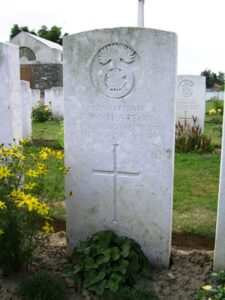
Henry Taplin, Private, 10504, East Yorkshire Regiment. Henry was born at Bethnel Green. He lived at Felinfoel prior to the war, possibly with Miss Mary Jenkins, and enlisted at Llanelli into the 2nd Battalion, East Yorkshire Regiment. The battalion was among those brought back to Britain from around the Empire, and joined 83 Brigade, 28th Division. The division moved to France around 18 February 1915, and moved to positions east of Ypres. Henry was killed in action soon afterwards, on 27 February 1915. He has no known grave, and is commemorated on the Ypres (Menin Gate) Memorial, Belgium. Henry is not commemorated locally.
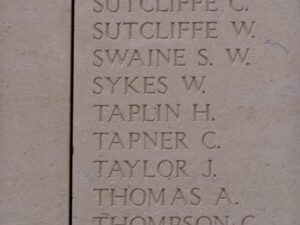
Walter Ellis Thomas, Private, 40358, Cheshire Regiment. Walter was the son of Henry and Sarah Thomas, of Alma, Felinfoel. He worked as a chemist with his brother at Swansea prior to the war and enlisted there into the Welsh Regiment on 10 December 1915. On 19 September 1917 he transferred into the 15th Battalion, Cheshire Regiment, which was part of 105 Brigade, 35th Division. The Division had been in France since January 1916, and had seen much fighting on the Somme that year. After spending several months regaining lost strength, the Division then went back into the line, and followed the German Retreat to the Hindenburg Line in March 1917. Later in the year they moved north to Ypres, and fought at the Second Battle of Passchendaele. By Spring of 1918 they were back on the Somme, and fought at the First Battle of Bapaume, during the German Offensive. Walter was posted as missing on 28 March 1918, and was later found by a court of enquiry to have been killed on that date, aged 24. He has no known grave, and so he is remembered on the Pozieres Memorial, France. Walter is shown as a Lieutenant on the memorial, but this is the correct man.
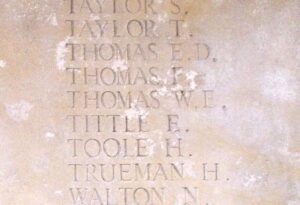
William Llewellyn Thomas, Private, 34133, South Lancashire Regiment. William was the son of William Llewellyn Thomas and Martha Thomas, of Wenvoe House, Pentrepoeth, Llanelly. He enlisted at Llanelli into the Royal Welsh Fusiliers, but later transferred into the 1/5th Battalion, South Lancashire Regiment, which was part of 166 Brigade, 55th (West Lancashire) Division. The Division moved to France during January 1916, and relieved the French 88th Division south of Arras, in the area Wailly- Bretencourt. Trench warfare commenced, with many raids and minor operations, until the Division was relieved by the 11th (Northern) Division on 25 July 1916 and moved to the Somme. Here they fought at the Battle of Guillemont and the Battle of Ginchy. There was a short period of rest at Ribemont during September, and then the Division fought at the Battle of Flers-Courcelette and the Battle of Morval. On 28 September, the Division withdrew to the area of Buire and Ribemont, before relieving the 29th Division in the Ypres salient in October 1916. It was destined to remain in this area for almost a year, stationed near Railway wood. At the end of July 1917 the Division fought at the Battle of Pilkem, and after suffering terrible casualties, was withdrawn to Recques for re-fit and training, before moving back into the line on 15 September, and fighting at the Battle of the Menin Road. The Division moved out of the line from 22 September and moved to positions near Honnecourt wood and Lempire-Ronssoy, and fought at the Battle of Cambrai. The Division faced the enemy counter attack on 30 November 1917, and were decimated, with the 1/5th Battalion, the South Lancashires being totally annihilated. The Division’s reputation fell sharply in the eyes of the higher command, and it was withdrawn from the area and sent to Bomy, near Fruges for intensive training. The Division relieved 42nd (East Lancashire) Division in the front line at Givenchy and Festubert on 15 February 1918, and faced numerous strong enemy raids in March. April was at first much quieter, but it was a lull before the storm, as the Germans launched another offensive here, with the Division taking part in the Battle of Estaires. William was wounded here, and sadly died of wounds on 23 April 1918, aged 41. He is buried at Pernes British Cemetery, France. There is an inscription to his memory on his parents grave at Felinfoel Churchyard. Many thanks to Emma Lister for the photograph of William.
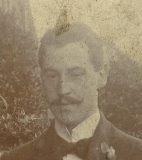
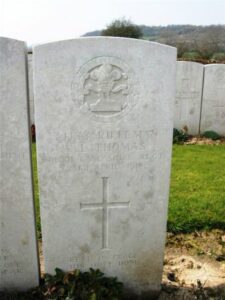
Sydney Williams, Corporal, 13163, Royal Welsh Fusiliers. Sydney was the son of David and Jane Williams, of 5, Park View Terrace, Llanelli. He enlisted there into the 9th Battalion, Royal Welsh Fusiliers, which was part of 58 Brigade, 19th (Western) Division. The Division crossed to France during July 1915, and moved to positions near Loos, form where they fought during the opening attack of the Battle of Loos, on 25 September 1915. Sydney was wounded at Loos, and brought back to the UK for treatment, but sadly died of wounds on 20 October 1915. He was 24 years old, and is buried at Felinfoel (Adulam) Baptist Burial Ground. Many thanks to Sarah Bassett for the photo of his grave.
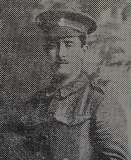
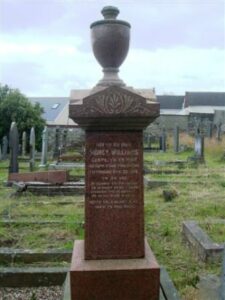
William David Williams, Corporal, 134403, Royal Air Force. William was born at Pembrey on 25 April 1891, the son of Thomas and Amelia Williams. He enlisted into the 10th Battalion, Welsh Regiment on 9 November 1914 and served with the battalion until being shot in the side whilst the battalion was in the line at Boesinghe on 30 May 1917. Following a lengthy recovery, on 24 January 1918 he transferred to the Royal Flying Corps, which merged with the Royal Naval Air Service to form the Royal Air Force soon afterwards. He was posted to Cranwell for training, but soon became ill. William was discharged after being found to have contracted tuberculosis and married Margaret Evans, of 13, Tyrynis, Felinfoel soon afterwards. William died on 5 February 1922, aged 32. He is not commemorated by the CWGC.
World War Two, 1939-1945
Reginald John Andrews, Bombardier, 2021926, Royal Artillery. Reginald was the son of Ernest John Andrews and Elizabeth Andrews (nee John), of Llanelli. He married Ethel Davies, of Felinfoel, in 1933. He served with 484 (Carmarthenshire) Searchlight Regiment, Royal Artillery, which was an anti aircraft unit, equipped with the Bofors gun. Reginald died in hospital at Neath on 25 September 1940. He was 28 years old, and is buried at Llanelli (Box) Cemetery. The battery later embarked for overseas to serve in Egypt and Malta. His brother Henry also fell.
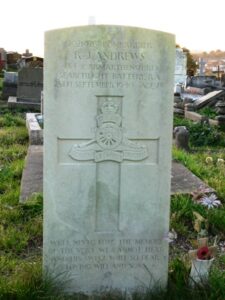
Frank Anthony, Gunner, 2050606, Royal Artillery. Frank was the son of Samuel and Emily Anthony, of Llanelly, and the husband of Margaret Elizabeth Anthony, of Felinfoel. He served with 484 Battery, 4 Searchlight Regiment, Royal Artillery, which was stationed at Malta from 1941. Frank was killed at Malta on 21 December 1941, when his searchlight was knocked out during an air raid on the island. He is buried alongside two of his fellow crew-members. Frank was 37 years old, and is buried at Pembroke Military Cemetery, Malta.
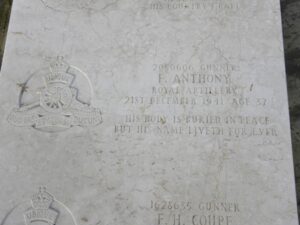
William John Clement, Able Seaman, D/JX 168866, Royal Navy. William was the son of Matthew and Gertrude Mary Clement, of Llanelly, and served with the Royal Navy aboard HMS Vyner Brooke, which had been requisitioned by the Admiralty for troop carrying. When the Japanese invaded Singapore, Vyner Brooke was ordered from Singapore, carrying Nurses and evacuees. She sailed on the night of 12 February 1942, but on entering The Banka Straits was attacked by nine Japanese planes. Vyner Brooke was hit repeatedly, with the Bridge being totally destroyed, and the steering gear out of order, so the Captain gave orders for the ship to be abandoned. In just over twenty minutes Vyner Brooke sank. William is recorded as having died on 14 February 1942, so was probably killed during the attack on the ship. Most of the survivors landed on a beach near Muntok where they set up a camp and commenced tending the wounded. A couple of days later, on 16 February, the survivors were discovered by a Japanese patrol. Those that could walk were lined up and shot, those who were lying wounded were bayoneted to death, with only one survived the bayoneting. The nurses were then ordered to walk into the sea, and on reaching waist height the Japanese machine gunned them. William was 22 years old, and is now remembered on the Plymouth Naval Memorial, Devon.
Ronald Howell Davies, Corporal, 3963531, Welch Regiment. Ronald was the son of Thomas and Mary Elizabeth Davies, of Felinfoel, and served with the local Territorial unit, the 4th Battalion, Welch Regiment. The battalion formed part of the 53rd (Welsh) Division, and spent most of the war training, based in Northern Ireland for a time. In June 1944 the Division landed at Normandy, and took part in the break-out from the beach-head, and the drive through France and Belgium into Holland. Ronald was killed during the Battle of the Bulge on 7 January 1945. He was 25 years old, and is buried at Hotton War Cemetery, Belgium. His brother Wilfred Howell Davies also fell.
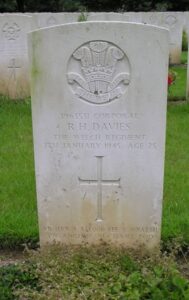
Sidney Davies, Stoker, LT/KX 111474, Royal Naval Patrol Service. Sidney was the son of Gwilym and Blodwen Davies, of Llanelly, and the husband of Muriel Davies, of Felinfoel. He served with the Royal Naval Patrol Service aboard HM Trawler Arctic Trapper, which was based at Ramsgate. Sidney was killed when she was machine gunned and sank by German fighters off Ramsgate on 3 February 1941. He was 30 years old, and is commemorated on the Lowestoft Naval Memorial, Suffolk. Sidney is not commemorated on the Felinfoel Memorial.
Wilfred Howell Davies, Lance Corporal, 6411190, Welch Regiment. Wilfred was the son of Thomas and Mary Elizabeth Davies, and the husband of Hetty Davies, of Felinfoel. He served with the local Territorial unit, the 4th Battalion, Welch Regiment. The battalion formed part of the 53rd (Welsh) Division, and spent most of the war training, based in Northern Ireland for a time. In June 1944 the Division landed at Normandy, and took part in the break-out from the beach-head, and the drive through France and Belgium into Holland. Wilfred was killed in Normandy on 15 August 1944. He was 29 years old, and is buried at Ranville War Cemetery, France. His brother Ronald Howell Davies also fell.
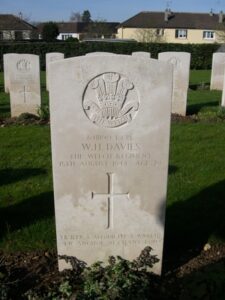
William James Edwards, Driver, T/3969260, Royal Army Service Corps. William was born on 20 February 1916, the son of James Edwards and Catherine Jane Edwards (nee Henshaw), of 1, Pleasant View, Felinfoel. His uncle, Ivor Thomas Henshaw, had been killed in Gaza with the 4th Welsh during the Great War. William worked as a painter for the council prior to the war, before enlisting into the Royal Army Service Corps, where he trained as a driver. He landed in Normandy with the 47th Company, RASC soon after the Normandy Landings of 6 June 1944. William was badly wounded during the early stages of the battle for Normandy and died of his wounds on 18 July 1944. The 28-year-old was originally buried at Colleville-Sur-Orne, but in June 1945 the war graves in the area were exhumed and he was re-interred in La Delivrande War Cemetery, Douvres, France.
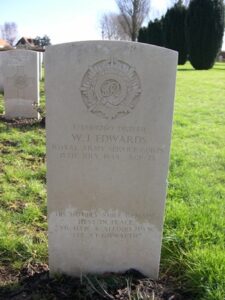
Thomas Festubert Evans, Gunner, 1827284, Royal Artillery. Thomas was born on 12 July 1915, the son of Thomas John Evans and Rebecca Evans (nee Rees), of Felinfoel. He married Sylvia John in 1933 and the couple resided with Thomas’s parents at 10, Farmers Road, Felinfoel. Thomas worked as a duster in the local tinworks prior to the war, then enlisted into the Royal Artillery. He was posted to the Far East to join 48 Battery, 21 Light Anti Aircraft Regiment, Royal Artillery, which was based at Singapore. Thomas was taken prisoner when the Singapore Garrison surrendered to the Japanese in December 1941, and was given the POW No. 2521. He was one of thousands of men forced to march to Sandakan Number 2 Camp from the Number 1 Camp around 15 April 1945. Survivors were then moved back to a wired section of Number 2 Camp on 29 May 1945. Thomas died during the march on 14 July 1945 and was buried in the jungle. The 30-year-old has no known grave and is commemorated on the Singapore Memorial, Singapore. Many thanks to Nigel Anstey for the photograph.
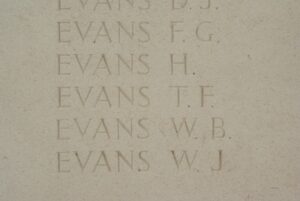
Colin Hawley Harris, Corporal, 319277, Royal Armoured Corps. Colin was the son of Albert Harris and Gladys Harris (nee Leak), of Llanelly. He married Matilda Thomas, of Dafen, in 1940. Colin enlisted into the army and was posted to the 16th/5th Lancers, which was part of the Royal Armoured Corps. The regiment was then posted to North Africa and became attached to the 6th Armoured Division. Colin was badly wounded during the Battle of the Kasserine Pass, when the 6th Armoured Division was rushing to the assistance of the beleaguered American II Corps, and died of his wounds on 20 February 1943. He was 24 years old, and is buried in Enfidaville War Cemetery, Tunisia.
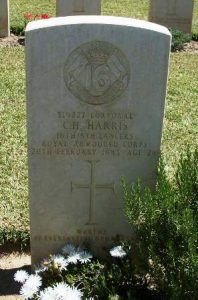
John Moore Harries, Gunner, 1133744, Royal Artillery. John was born in 1921, the son of John Elloway Harries and Ethel Elizabeth Harries (nee Brinn), of Felinfoel. He enlisted into the army and was posted to the 111th Field Regiment, Royal Artillery, a Territorial Army unit which had been raised in Bolton. In October 1942 the regiment Egypt to join the 50th (Northumbrian) Division, and took part in the epic fight in the Western Desert, John was killed together with two of his comrades during the Battle of El Alamein on 24 October 1942. The 20-year-old was originally buried on the battlefield, but in July 1943 his grave was exhumed and he was re-interred in El Alamein War Cemetery, Egypt.
Henry Haydn Heaven, Gunner, 2036339, Royal Artillery. Henry was born in 1918 the son of Henry Frederick Heaven and Mary Ann Heaven (nee John), of Llanelli. He married Margaret Iris Jenkins in 1939 and the couple resided at 4, Ynyswen, Felinfoel. Henry enlisted into the army and was posted to North Africa to join the 134th Battery, 41st Light Anti Aircraft Regiment, Royal Artillery. Henry was killed in an accident whilst serving in North Africa on 24 March 1943. The 25-year-old was originally buried in an isolated grave, but in May 1944 his grave was exhumed and he was re-interred in El Alamein War Cemetery, Egypt.
David Vernon Howells, Private, 3909190, Welch Regiment. David was born in 1919, the son of Thomas Howells and Lilian Howells (nee Morgan), of Felinfoel. He enlisted into the Welch Regiment, and upon completing his training was posted to the Mediterranean. David was accidentally killed during the invasion of Italy on 9 August 1944. He was 24 years old, and is buried at Bari War Cemetery, Italy. There is no mention of which battalion of the Welch Regiment he was serving with at the time of his death, but it was presumably the 1st Welch.
Philip Rice Hughes, Home Guard. Philip was born on 5 February 1907, the son of Arthur Rice Hughes and Elizabeth Hughes, of Farmers Row, Felinfoel. He was educated at Llandovery College before leaving Felinfoel to work in Newport and married Phyllis Mai Hardwick there in 1936. The couple then moved to London and settled at 23, Whittell Gardens, Lewisham. Following the outbreak of war Philip enlisted into the Home Guard. He was killed at home during an air raid on 1 October 1940. The remains of the 33-year-old were brought home and he was buried in Holy Trinity Churchyard, Felinfoel. Philip is not commemorated on the Felinfoel War Memorial.
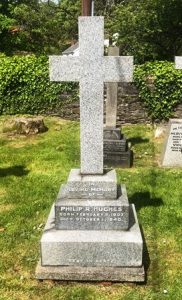
Emrys Herbert Humphreys, Master, Canadian Merchant Navy. Emrys was born in Manchester on 7 March 1885, the son of Benjamin Humphreys and Mary Elizabeth Humphreys (nee Williams). His father was a Baptist Minister from Talybont in Cardiganshire, and in 1889 accepted the invitation from the congregation of Adulam Chapel at Felinfoel to become their Minister. Emrys was educated at Llanelli, before going to sea, joining the Mercantile Marine as a young man, and by April 1909 had gained his certificate as First Mate. Soon after the outbreak of war, Emrys gained a temporary commission as Sub-Lieutenant into the Royal Navy, and he served throughout the conflict aboard several ships. Emrys was eventually demobilised on 12 October 1919 and returned to his pre-war occupation, rejoining the Mercantile Marine and joined the Seaboard Shipping Company, of Canada. Emrys worked for the company for many years prior to the outbreak of the Second World War, settling at Vancouver with his wife Betty Rose, and their two children. By 1939 he was in command of the Vancouver registered cargo ship, the SS Admiral Day. Early in 1940, Admiral Day became wrecked in the Coral Sea, and the crew were rescued by the Australian ship, HMAS Manoora. Upon his safe return to Canada, Emrys was placed in command of the Montreal registered SS Maplecourt, an antiquated merchant ship which had originally been built for work on the Great Lakes. On 6 February 1941, Maplecourt was steaming in the North Atlantic behind Convoy SC-20, from Montreal bound for Preston, when she was hit by a torpedo which had been fired by the German submarine U-107. The torpedo struck the stern of the helpless ship, which began to sink. The Germans observed the crew of the Maplecourt take to their life rafts but they were never seen again, with Emrys, 35 crewmen and three gunners being lost. Emrys was 52-years-old when he was lost in the sinking of Maplecourt. He has no known grave but the sea, so is commemorated on the Halifax Memorial, Nova Scotia, Canada. Emrys is not commemorated locally at Felinfoel, but is commemorated on his parents headstone at Adulam Cemetery.
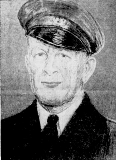
Phillip Richard Hurley, Gunner, 1722026, Royal Artillery. Phillip was born on 5 January 1912, the son of James Hurley and Mary Hurley (nee Shanahan), of Oxen Street, Llanelly. He married Doris Davies in 1932 and the couple set up home at 9, Dan Y Cwm, Felinfoel. Phillip worked as a builders labourer prior to the war, then enlisted into the Royal Artillery. He was posted to the 7/4 Maritime Regiment, Royal Artillery, as a DEMS Gunner aboard a merchant ship. Phillip was killed when the ship he was serving aboard, probably the SS Vancouver Island, was torpedoed and sank on 15 October 1941. The 29-year-old has no known grave, so is commemorated on the Plymouth Naval Memorial, Devon. Phillip is not commemorated on the Felinfoel Memorial.
Rhydian Jenkins, Driver, T/276799, Royal Army Service Corps. Rhydian was born on 17 August 1917, the son of Richard Jenkins and Elizabeth Anne Jenkins (nee Thomas), of the White Lion Inn, Felinfoel. He worked as an iron scaler in a sheet mills prior to the war. Rhydian enlisted into the army and was posted to the Royal Army Service Corps, training as a driver. He was then posted to Malaya and became attached to the Royal Artillery. Rhydian was captured by the Japanese at some time and was taken prisoner of war, being incarcerated at Kuching. He died there in captivity of beri beri on 6 June 1945. The 27-year-old was originally buried in Lintang Camp Cemetery, Kuching, but in January 1947 his grave was exhumed and he was re-interred in Labuan War Cemetery, Malaysia.
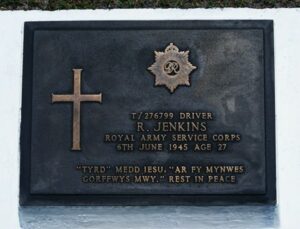
William Samuel John, Private, 3963326, Welch Regiment. William was born on 22 July 1918, the son of Luther John and Elizabeth John (nee Griffiths), of 8, Panteg, Felinfoel. He worked as a sheet packer in an enamel works prior to the war. William enlisted into the local Territorial Army unit, the 4th Battalion, Welch Regiment, which was attached to the 53rd (Welsh) Division. William was then attached to 108 POW Camp at Thirkleby in Yorkshire. He was among ten men attached to the Camp who went missing on 2 July 1940 and were later recorded as having died at sea. The 21-year-old has no known grave and is commemorated on the Brookwood Memorial, Surrey. Some research shows that a Prisoner of War Ship, the SS Arandora Star, was torpedoed and sunk off the northwest coast of Ireland by the German U-Boat U-47 that day, whilst conveying more than 400 German internees, 700 Italian internees and 86 German prisoners of war to Canada. Some 200 troops were guarding the prisoners. Among the dead were 592 Germans and Italians, 92 troops, and 57 crewmen.
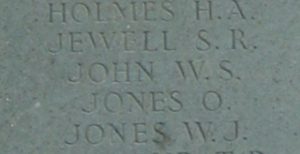
William Arthur Phillips Jones, Pilot Officer (Pilot), 43100, Royal Air Force. William was born in 1915, the son of Arthur Treharne Jones and Elizabeth Jones (nee Phillips), of 183, Felinfoel Road, Llanelli. He was educated at Llandovery College before being commissioned as Second Lieutenant into the 4th Welch on 29 October 1938. William then transferred to the Royal Air Force, and after training as a pilot was posted to No 2 School of Army Cooperation, based at Andover. William was flying a Bristol Blenheim IV, Serial T2321 on 20 November 1940 when it stalled on overshoot and crashed three miles west of Thruxton, killing him instantly. The remains of the 25-year-old were recovered from the wreckage and he was brought home for burial in Holy Trinity Churchyard, Felinfoel. William is not commemorated on the Felinfoel Memorial.
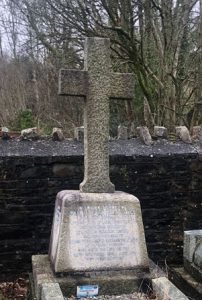
Frederick George Lawson, Bombardier, 2035896, Royal Artillery. Frederick was born in 1918, the son of William Lawson and Lily Beatrice Lawson (nee Leonard), of Felinfoel. He lived with his wife Sally Connie Lawson, at Llanerch, Llanelli. Frederick enlisted into the army and was posted to 484 Battery, 4th Searchlight Battalion, Royal Artillery. He survived the war, but died some months after the Armistice, on 5 January 1946. The 27-year-old was buried in Holy Trinity Churchyard, Felinfoel. A brother, Horace, was killed in Normandy in 1944. Frederick is not commemorated on the Felinfoel Memorial.
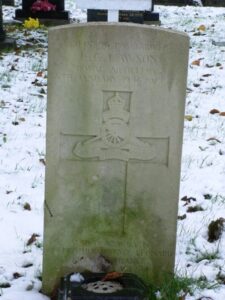
Horace Leonard Lawson, Fusilier, 14605776, Royal Welch Fusiliers. Horace was born in 1923, the son of William Lawson and Lily Beatrice Lawson (nee Leonard), of Felinfoel. He enlisted into the army soon after the outbreak of war and was posted to the 4th Battalion, Royal Welch Fusiliers, which was attached to 158 Brigade, 53rd (Welsh) Division. The battalion was mobilised at the outbreak of war, when the Division moved to Northern Ireland to begin garrison duties. The Division then moved to Pembroke Dock, before moving again to the south of England, where it trained in readiness for the D-Day Landings. On 24 June 1944 the 7th RWF left England for Normandy, and landed at La Riviere near Ver Sur Mer. The Division then took part in heavy fighting over the coming weeks, as part of the effort to break-out of the Normandy beach-head, seeing heavy fighting at Évrecy, before starting the epic advance through Northern France into Belgium and Holland. Horace was wounded on 19 July, during the capture of Evrecy, and died on 23 July 1944, aged 20. He is buried in Bayeux War Cemetery, France. His brother, Frederick George Lawson, died in the United Kingdom. Horace is not commemorated on the Felinfoel War Memorial.
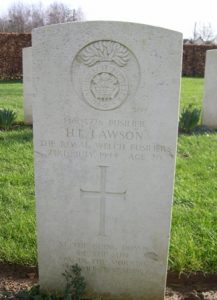
John Maddocks Lewis, MM, Corporal, 14541663, Royal Fusiliers (City of London Regiment). John was the son of John and Mary Lewis, of 2, Glanyrafon Row, Felinfoel. He enlisted into the army and was posted to the 9th Battalion, Royal Fusiliers, which was a Territorial Army unit, attached to the 167th (London) Infantry Brigade, 56th (London) Infantry Division. The battalion saw action in North Africa during the latter stages of the Tunisian Campaign before taking part in the landings on mainland Italy, landing at Salerno on 9 September 1943 and took part in the terrible fighting which followed. John won the Military Medal for bravery in the field during the invasion of Italy. His award was recommended by his CO, who wrote: ‘On the night of 16th September 1944, L/C Lewis was a section commander in the forward Coy, when the Battalion crossed the River Marano. It was very dark: and at one stage the platoon came under heavy artillery and machine-gun fire. The platoon commander became separated from his platoon, and there was no longer a platoon Sjt. L/C Lewis made an immediate appreciation and with complete disregard for the enemy fire he took command, collected the platoon, which was very scattered, and led them round to the flank to attack. He personally led the assault on the enemy post, killing or wounding the Germans in it, and re-organised the platoon there. His quick decision and immediate action, besides making an effective force again of his platoon, enabled the rest of the Company to continue the advance.’ His award of the Military Medal was published in the London Gazette of 6 March 1945. Sadly, John never lived to receive his medal as he had been killed in action on 16 February 1945. He was 21 years old, and is buried in Forli War Cemetery, Italy.
Harold Meyler, Gunner, 2092526, Royal Artillery. Harold was born in 1910, the son of William George Meyler and Charlotte Meyler (nee Edwards), of 2, Machynis Road, Llanelli. He married Gwyneth Mair Perkins in 1933 and the couple resided at 8, Danyrallt, Felinfoel. Harold originally enlisted into the Royal Engineers but was later posted to Malta and transferred to 484 Battery, 4 Searchlight Regiment, Royal Artillery. He was badly wounded during an air raid during the height of the Battle of Malta and died of his wounds on 7 April 1942. The 31-year-old was buried in Pembroke Military Cemetery, Malta.
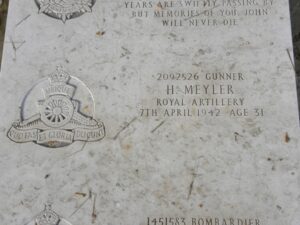
Constance Perrott, Civilian. Constance was born on 21 December 1890, the daughter of David Edward Perrott and Eliza Ann Perrott (nee Morgan), of 57, New Dock Road, Llanelli. She was killed when the Old Vicarage at St. Ishmael was hit by a German bomb on 1 September 1940. Constance was 40 years old and was buried in Holy Trinity Churchyard, Felinfoel. She is not commemorated on the Felinfoel War Memorial.
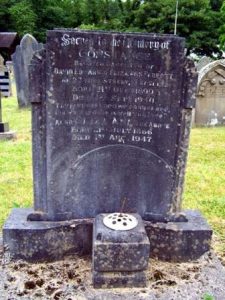
Hubert Bernel Pile, Second Engineer Officer, Merchant Navy. Hubert was born on 6 July 1899, the son of Charles William Pile and Annie Pile (nee Harries), of 6, Fron Terrace, Llanelli. He married Elizabeth Catherine Stone, of Felinfoel in 1925 and the couple set up home at 69, Glenalla Road, Llanelli. Hubert had gone to sea as a young man, and by the time that war erupted was serving as a 2nd Engineer with the Merchant Navy. During the war he served aboard the SS Ashbury, a Glasgow registered merchant ship. Hubert was killed when his ship was lost with all hands when in Convoy off the Isle of Tongue, Scotland on 8 January 1945, going down with the loss of 42 lives. The body of the 45-year-old was recovered from the sea and after being identified as him, was brought home for burial at Holy Trinity Churchyard, Felinfoel. Hubert is not commemorated on the Felinfoel Memorial.
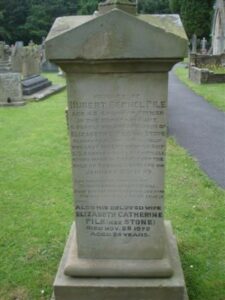
Glyn James Price, Corporal, 7899452, Royal Armoured Corps. Glyn was the son of Margaretta Price, and the stepson of George Jones, of Felinfoel. He served with “C” Squadron, 1st King’s Dragoon Guards, which was part of the Royal Armoured Corps. Glyn served with the Kings Dragoons throughout the North African campaign, and was killed in action during the invasion of Italy on 27 August 1944. He was 28 years old, and is buried at Arezzo War Cemetery, Italy.
Cecil James Jones Rees, Aircraftman 1st Class, 1417810, Royal Air Force Volunteer Reserve. Cecil was the son of John and Annie Rees, of Medelfyw, Felinfoel. He served with 145 Squadron, Royal Air Force, which was a fighter squadron, armed with the Supermarine Spitfire IIX, based at RAF Lentini West. Cecil served as ground-crew with the squadron in North Africa. He was accidentally drowned near Tripoli on 8 September 1943, aged 22, and is buried at Tripoli War Cemetery, Libya. Photograph of Cecil courtesy of his nephew, Steve Jones.
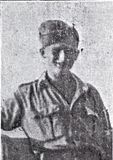
David Edgar Rees, Gunner, 2038695, Royal Artillery. David was the son of William and Esther Rees, and the husband of Margaret Rees, of Felinfoel. He had served during the war with the Royal Artillery. David died as a result of war wounds on 11 November 1947. He was 45 years old, and is buried at Felinfoel (Adulam) Baptist Burial Ground. David is not commemorated on the Felinfoel Memorial.
Ernest Thomas Rees, MID, Sergeant (Cadet Pilot), 524559, Royal Air Force. Ernest was the son of Ernest Graham and Lucie Rees, and the husband of Peggy Rees, of Dafen. Ernest was training as a Pilot in Zimbabwe when he was killed in an air crash on 14 May 1943. He was 27 years old, and is buried at Harare (Pioneer) Cemetery, Zimbabwe. At some time during the war Ernest was Mentioned in Despatches.
Herbert David Rees, Radio Officer, Air Transport Auxiliary. Herbert was the son of David and Catherine Ann Rees, of Felinfoel, and served with the Air Transport Auxiliary. The ATA was a civilian organisation that ferried new, repaired and damaged military aircraft between factories, assembly plants, transatlantic delivery points, Maintenance Units (MU), scrap yards, and active service squadrons and airfields. On 10 August 1941, Herbert was one of 22 people aboard a Consolidated Liberator I, Serial AM261, of Ferry Command. The aircraft had taken off in poor weather and was noted by those watching on the ground that the aircraft was climbing at the normal rate as it flew over the outer islands off the mainland. Nothing further was seen or heard of the aircraft until wreckage was discovered a few days later near the summit of a mountain some 25 miles from the take-off point, after having flown into the ground, killing all the occupants. Herbert was 27 years old, and is buried at Kilbride Old Churchyard, Scotland.
Thomas Gwynfil Rees, Gunner, 985114, Royal Artillery. Thomas was the son of Thomas and Elizabeth Ann Rees, and the husband of Betty Rees, of Llanelly. He served with the 98th (Surrey & Sussex Yeomanry) Field Regiment, Royal Artillery, which was part of the British Expeditionary Force in France at the outbreak of war. Thomas was caught up in the retreat from Lille to Dunkirk in May 1940. He was wounded, but evacuated safely back to Britain. He died as a result of his wounds on 18 September 1940. Thomas was 25 years old, and is buried at Felinfoel (Holy Trinity) Churchyard. Thomas is not commemorated on the Felinfoel Memorial.
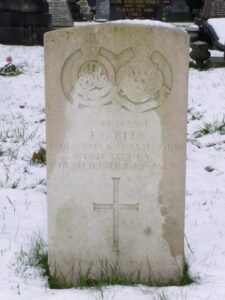
William David Hector Rees, Guardsman, 2735646, Welsh Guards. William was the son of Hector and Edith Rees of Felinfoel, and the husband of Marion Ada Rees, of Great Barr, Birmingham. He served with the 2nd Battalion, Welsh Guards, which had been raised in May 1939. The battalion took part in the defence of Boulogne in May 1940, and the survivors were evacuated back to Britain, where they remained until taking part in the Normandy invasion in June 1944, by which time they had converted into an armoured unit. William was killed during the fighting in the Bocage on 3 August 1944. He was 24 years old, and is buried at St. Charles De Percy War Cemetery, France.
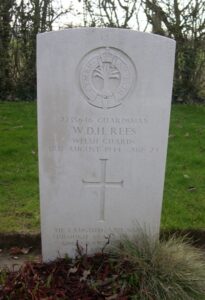
David John Richards, Sergeant (Air Gunner), 1418379, Royal Air Force Volunteer Reserve. David was the son of David and Elizabeth Ann Richards, and the husband of Dorothy Elizabeth Richards, of Llanelly. He served as an Air Gunner with 35 Squadron, Royal Air Force, which was a bomber unit, equipped with the Handley Page Halifax II, based at RAF Gravely. David was killed when his Halifax was brought down over Holland while returning from a raid on Germany on 13 May 1943. He was 23 years old, and is buried at Haaksbergen General Cemetery, Netherlands.
Thomas John Thomas, Corporal, 3962531, Royal Fusiliers (City of London Regiment). Thomas was the son of Mr. and Mrs. Abel Thomas, and the husband of Eleanor Thomas, of Llanelly. He served with the 2nd Battalion, Royal Fusiliers. The battalion fought in the Western Desert during the war, after moving from Scotland in 1942. Thomas was killed in North Africa on 29 April 1943. He was 25 years old, and is buried at Massicault War Cemetery, Tunisia.
Leslie Williams, Gunner, 2036598, Royal Artillery. Leslie was the son of Mr. and Mrs. E. J. Williams of Felinfoel, and the husband of Margaret Williams, of Freckleton, Lancashire. He served with 216 Battery, 70 Heavy Anti Aircraft Regiment, Royal Artillery, which was based in India. Leslie died in India on 17 May 1943. He was 24 years old, and is buried at Kirkee War Cemetery, India.